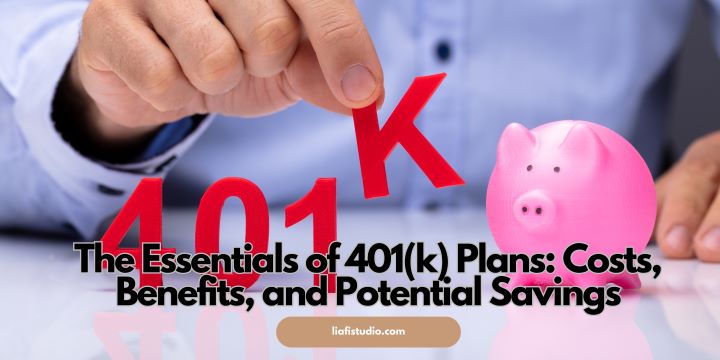Table of Contents
- Introduction to 401(k) Plans
- Understanding the Costs
- Benefits of a 401(k) Plan
- Potential Savings with a 401(k)
- Real-life Example of 401(k) Benefits
- Additional Resources
Introduction to 401(k) Plans
Many Americans consider 401(k) plans a cornerstone of retirement planning. Many employers provide these programs to enable workers to set aside and invest a part of their salary before tax deductions. A thorough grasp of the pros and cons of 401(k) plans can help you make informed financial health choices. To estimate your retirement potential, a 401(k) calculator is highly recommended for accurate projections. An essential benefit of a 401(k) plan is increasing your retirement funds without paying taxes immediately. It means the money you contribute and its investment growth will be taxed once you withdraw it during retirement. However, it’s crucial to grasp both the benefits and the associated costs to maximize the advantages of this savings vehicle. These plans can be an excellent tool for building a secure financial future, but understanding how to navigate them is essential.
Understanding the Costs
Administrative Fees
Administrative fees are the costs of maintaining and managing the 401(k) plan. These fees cover record-keeping, compliance, and customer service. Although they vary from one plan to another, knowing these fees can help you choose a plan that offers good value. Administrative costs can add up over time, so it’s crucial to understand how they impact your overall investment returns. Always carefully read the fee disclosure documents provided by your plan administrator.
Investment Fees
Investment fees are charged by the companies that manage the mutual funds or other investment options in your 401(k) plan. Awareness of these fees is essential because they affect your overall investment returns. Usually, these are expressed as a percentage of the assets under management. Higher fees can erode your investment gains, so it’s worth comparing the expense ratios of different fund options within your plan. Even a slight difference in these fees can significantly impact over the long term.
Service Fees
Some 401(k) plans may have additional service fees for specific actions, such as taking a loan from your account or making a hardship withdrawal. Knowing these potential costs upfront can help you plan better and avoid unexpected expenses. Service fees are often less transparent than others, so it’s worth inquiring about additional charges with certain transactions. Understanding the terms and conditions of your plan can help you avoid these fees.
Benefits of a 401(k) Plan
Tax Advantages
One of the most significant benefits is the tax advantage. Contributions are made pre-tax, lowering your taxable income for the year. Additionally, the growth of your investments is tax-deferred, which means you only pay taxes on the earnings once you withdraw the funds. This tax deferral can boost your savings significantly over the years as more of your money remains invested and earning returns. Utilizing tax advantages can dramatically affect how much you save by retirement age.
Employer Matching
Many employers offer matching contributions, giving you free money to bolster your retirement savings. An employer could contribute half (50%) of your contributions to your retirement account but only up to 6% of your salary. This benefit can significantly accelerate your savings growth. Employer matching is a critical benefit you should take full advantage of; it’s essentially free money that can make a substantial difference in your retirement savings. Failing to capture this match is leaving money on the table.
Compound Growth
The principle of compound growth means that the earnings on your investments generate their earnings over time. This effect can substantially increase your retirement savings, especially if you start contributing early. The earlier you start, the more time your money has to grow exponentially. Compound interest is a beneficial tool that can assist in reaching your retirement objectives quicker than you think.
Potential Savings with a 401(k)
The savings potential in a 401(k) plan can be substantial. The power of compounding, combined with regular contributions and employer matching, can result in a significant retirement nest egg. Consistent 401(k) contributions have helped many workers accumulate considerable retirement funds. This illustrates the importance of starting your savings early and contributing regularly to maximize compound growth and employer benefits. Achieving substantial savings in a 401(k) requires discipline and planning. Consistently contributing as much as you can afford, especially up to any matching limit set by your employer, will maximize your total savings. Regularly reviewing and adjusting your investment choices based on performance and changing risk tolerance can optimize your returns.
Real-life Example of 401(k) Benefits
Consider an individual who contributes $5,000 annually to their 401(k) at 25. If they earn an average annual return of 7%, they could amass $1 million by retiring at 65. Beginning to consistently contribute to your 401(k) at an early stage can significantly improve your financial security in retirement. This example underscores the importance of immediately beginning your retirement savings journey. The earlier you start, the more time compound interest has to work magic.
Even if you start later in life, there is always time to begin making contributions. Altering your savings rate and choosing investments that align with your risk tolerance and retirement objectives can lead to considerable savings. The key is to start contributing and to remain consistent with your savings efforts. You may need to make sacrifices in the short term, but the long-term benefits can provide a more comfortable and secure retirement.
Additional Resources
You can refer to resources for further information on optimizing your 401(k) plan. Staying informed about your retirement options helps you make the best financial decisions for your future. Understanding the various tools and strategies available for retirement planning, such as diverse investment options and periodic financial reviews, can ensure that your retirement savings are on track. Additionally, seeking guidance from a financial advisor can offer individualized advice and tactics customized to your financial circumstances. Whether you’re new to 401(k) plans or a seasoned investor, staying updated on financial news and market trends is always beneficial for making informed and effective decisions regarding your retirement savings.




